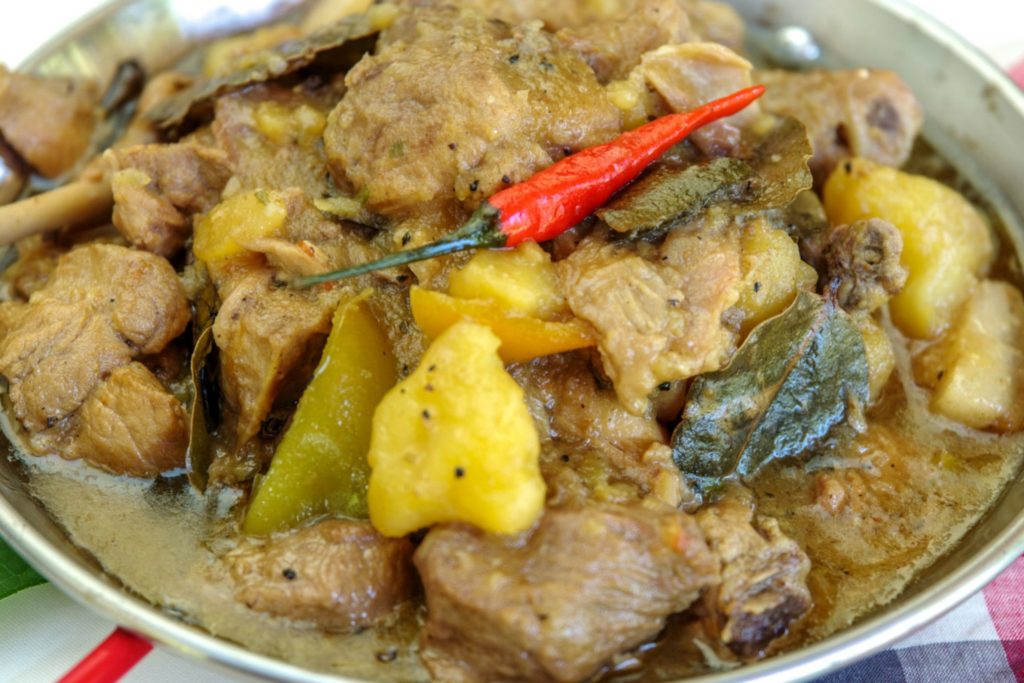
Filipino Ginataang Adobo sa Dilaw Recipe (Adobo in Turmeric)
Golden Memories, Golden Dish: Adobo sa Dilaw Recipe
Have you ever craved a dish that bursts with nostalgia? For me, that dish is Adobo sa Dilaw. Unlike the soy sauce-based Adobo most people know, this version features vibrant yellow turmeric, creating a sunshine-colored masterpiece that sings with flavor. Forget the confusion with Indian curries either– this Adobo sa Dilaw is a unique Filipino recipe that does not use curry powder. Today I’m sharing my family’s recipe to bring a taste of my childhood to your kitchen!
I have rich childhood memories of this Adobo sa Dilaw. Truth to tell, this was more familiar to me when I was growing up than the Tagalog Adobo in soy sauce.
The vibrant yellow color of Adobo sa Dilaw can sometimes lead to confusion with Indian curries. But while it uses luyang dilaw (turmeric), a common ingredient in curries, the flavor profile is completely different. I discovered this firsthand when I encountered pre-made curry packets in Manila – the taste was nothing like the Adobo sa Dilaw I knew. Even restaurant versions can vary quite a bit.
This chicken and pork adobo sa gata is stewed in vinegar, then finished off with gata for an oily creamy and rich sauce. Delicious!
Adobo sa Dilaw Recipe

Ingredients:
- 1/2 kilo Pork Adobo Cut (1-inch pork cubes)
- 1/2 kilo Chicken Adobo Cut (1 -2 inch inch chicken parts)
- 1 head garlic, peeled and minced
- 1 finger luyang dilaw smashed and peeled (turmeric) (or 1 tbsp powder)
- 1 tbsp patis (fish sauce)
- 1 potato cubed (optional)
- ½ tsp peppercorns
- 2 bay leaves
- 1 cup water
- ½ cup vinegar
- ¼ cup vinegar (1)
- ¼ cup soy sauce
- 1 tbsp oil
- 1 cup coconut milk
- 3 to 4 Thai chili peppers, stemmed and chopped
- sili leaves (optional)
- salt to taste
Instructions:
Here’s a more detailed version of the instructions for making Adobo sa Dilaw:
Step 1: Initial Braise
- In a pot or Dutch oven, heat up your oil over medium heat. Once hot, add your pork and chicken pieces.
- Pour in the patis (fish sauce) and the first ¼ cup of vinegar. Stir everything together to coat the meat.
- Bring the mixture to a boil, then lower the heat and simmer for about 5-7 minutes. Keep stirring occasionally to ensure the meat browns evenly on all sides. This initial braising process helps sear the meat, locking in its flavor and creating a base for the delicious sauce. You’ll see the liquid gradually reduce and the meat turning a beautiful golden brown.
Step 2: Building the Flavor
- Once the meat is browned, it’s time to add the aromatics and other flavor builders. Toss in your minced garlic, smashed turmeric (or turmeric powder), whole peppercorns, and bay leaves. Give everything a good stir to combine the flavors. Add the cubed potatoes (if using),
- Pour in the remaining water, vinegar (½ cup), and soy sauce (¼ cup). Stir well to scrape up any browned bits stuck to the bottom of the pot. This deglazing process adds extra flavor to the sauce.
- Bring the mixture back to a boil, then lower the heat again. Cover the pot and simmer for about 15 minutes, or until the meat is almost tender.
Step 3: Creamy Perfection
- After 15 minutes, uncover the pot and add the coconut milk. Stir gently to incorporate it into the sauce.
- Now comes the heat! Add your chopped chili peppers according to your desired spice level. Start with less and adjust to taste if you prefer it hotter.
- Give everything a good stir, then bring the mixture back to a simmer. Cover the pot and continue simmering for another 10-15 minutes, or until the meat is completely cooked through and the sauce has thickened to your liking. The creamy coconut milk will create a rich and flavorful sauce that coats the meat beautifully.
- Finally, if you have them, toss in the sili leaves for an extra layer of aroma and subtle peppery flavor. If you don’t have sili leaves, you can simply leave them out. The dish will still be as delicious!
- Season the entire dish with salt to taste. Remember, the patis and soy sauce already add some saltiness, so adjust gradually until you reach the perfect balance.
Step 4: Serve and Enjoy!
- Once you’re happy with the flavor and consistency of the sauce, remove the pot from the heat.
- Serve your Adobo sa Dilaw hot over steamed rice, with a side of vegetables if desired. Enjoy this flavorful and comforting Filipino dish!
Variations for Adobo sa Dilaw
Adobo sa Dilaw isn’t a one-size-fits-all dish! While this recipe offers a delicious foundation, there are regional variations that add a unique twist. Batangas, where the dish is believed to originate, is known for a drier sauce. Originally, our Dinilawang Manok in Marinduque does not have potatoes. Cavite, on the other hand, brings a richer, thicker experience by adding ingredients like chicken liver, extra broth, and even breadcrumbs. Some regions might add a touch of sweetness with brown sugar or pineapple, while others might focus on just chicken, pork, or even explore options like shrimp or fish. The spice level can also vary, so feel free to adjust the chili peppers to your preference. Embrace the diversity – there’s a perfect Adobo sa Dilaw waiting to be discovered in every corner of the Philippines!

Hello! I am April
...I don't know exactly what a prayer is. I do know how to pay attention, how to fall down. into the grass, how to kneel down in the grass, how to be idle and blessed, how to stroll through the fields, which is what I have been doing all day. Tell me, what else should I have done? Doesn't everything die at last, and too soon? Tell me, what is it you plan to do with your one wild and precious life?
- That Summer Day. Mary Oliver Tweet










